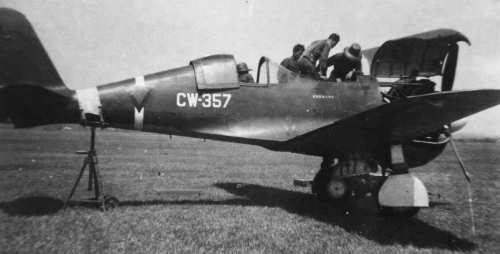
Posted on 01/15/2009 8:33:31 AM PST by Homer_J_Simpson

The plane pictured above did not go on to a distinguished career. Here is what Wikipedia has to say about it.
Design and development
The CW-21 was not commissioned by the U.S. military, though it was test flown at Wright Field in Dayton, Ohio. The Army Air Corps immediately rejected the aircraft, with one officer commenting that it took a genius to land it.[1] Instead it was developed for export sales by the St. Louis Airplane Division of Curtiss-Wright. The aircraft was a single seat, all-metal cantilever low-wing monoplane with rearward retracting landing gear. The Model 21 was powered by a 1,000 hp (750 kW) Wright Cyclone nine cylinder air-cooled radial Wright R-1820-G5 engine. The Model 21 was designed by George A. Page, Jr. based on Carl W. Scott's design of the two seater Model 19. The prototype first flew in January 1939 and bore the civil experimental registration NX19431. The prototype was designed to carry various combinations of two 0.3 or 0.5 inch (7.62 mm or 12.7 mm) machines guns, mounted in the nose and synchronized to fire through the propeller.
Operational history
The first sale of the CW-21 Demon in 1939, was to the Chinese Air Force, which received three completed examples and kits for 32 more. Assembly would be undertaken by the Central Aircraft Manufacturing Company (CAMCO) located in Loiwing on the China-Burma border. These were armed with one 0.3 and one 0.5 inch (12.7 mm) machine guns. Three CW-21s were furnished to the Chinese as kits, assembled in Loiwing, and delivered to the 1st American Volunteer Group (Flying Tigers). These crashed in poor visibility on a flight from Rangoon to Kunming on 23 December 1941.
In 1940, The Netherlands ordered 24 examples of a modified version designated the CW-21B (together with a number of two-seat CW-22), for the Royal Netherlands East Indies Army Military Aviation (Militaire Luchtvaart van het Koninklijk Nederlands-Indisch Leger; ML-KNIL).
The modifications consisted of inward retracting landing gear, a semi-retractable tail wheel, two each 0.3 and 0.5 inch (7.62 and 12.7 mm) machine guns, and a slightly larger fuel tank. These changes gained an eight mph (13 km/h) speed increase at sea level.
Boy, that thing is ugly.
It wouldn’t be much of a bomber interceptor with only one .30 and one .50 for armament. Even Japanese bombers, which generally weren’t well-protected with armor, would take more than that to bring down unless the pilot was very good or very lucky.
}:-)4
Boy, that thing is ugly. ..................... Agree, but it would look better with a nose job. Put a cone over the propeller, and Bingo, it looks like P40. :o)
Good dogfighter but poorly armed.
Sorta like an American KI-43 Hayabusa.
It looks like it’s got some P-36/P-40 lineage in it, that’s for sure.
}:-)4

That is one UGLY bird alright.
That’s got to be the ‘B’ model they built for the Dutch. (Landing gear goes in, instead of back).

Notice it also has the inward landing gear.
Here's one with the original landing gear
That's about the only picture of the A model I could find. I'm sure there's better pictures of them out there somewhere.
I just googled a picture of the BT-32 Condor bomber mentioned up thread. That’s an exceedingly ugly aircraft. Looks like state of the art for a World War I plane, but built in the 1930s.
From Joe Baugher's Webpage.
Disclaimer: Opinions posted on Free Republic are those of the individual posters and do not necessarily represent the opinion of Free Republic or its management. All materials posted herein are protected by copyright law and the exemption for fair use of copyrighted works.